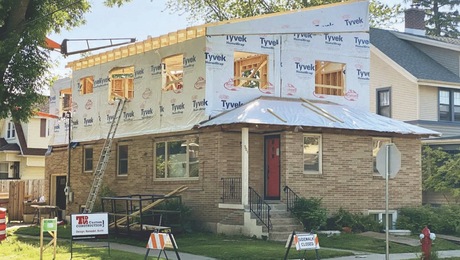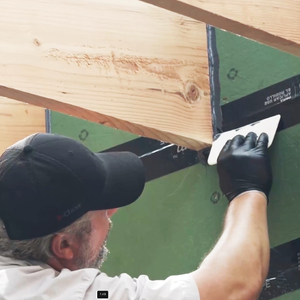Hi. I’m a new guy here. I’ve been a handyman for the past ten years doing all sorts of jobs in the Seattle area. I have a beam repair in a ski chalet that I own with friends and I need some help.
The beam runs about 15′ and supports a roof above in the chalet It is located inside the living area and is accessible from below but not above. The problem is that it got wet from a roof leak and rotted in the center. I would like to repair it without having to remove it as it is encased in drywall and trim.
The beam is composed of six 2×12’s sistered together running the full length. The rot is only in the center 4 boards and only for about two feet of the span. The outer two boards are in tact. The load is only the roof and not any floors above.
Once I clean out the rotted wood, is there some way to put in new structure that will provide similar support?


















Replies
Have you tried looking into the Abatron products? They claim that their structural epoxy will fix a beam. I called them up regarding a fix for a 4 x 10 that had rot damage, and they suggested that I bury some rebar in with the fix and it should hold. I've haven't done that yet — I chickened out and replace the whole beam — but I have successfully used their structural epoxy to do a lot of other repairs where I could not replace the beams, flooring, etc., and where using bondo was not feasible.
I would not use those products on such a repair as this. This is a load that has to have horizontal deflection bearing strength. I have used them on rotted posts where it is a vertical straight load bearing all the way down to fondation or something comparable and it is great. Unless the epoxy has the blessings of an engineer or some other higher up, I would go the usual way and sister in some 2x12 material or a steel flitch.
You're right Jer. I was thinking that the rot was spread only over the surface and not going any deeper than an inch or so here and there over the two feet. If that thing was properly engineered, there should be enough fudge factor there for that. Guess the Abatron people are so confident about their products that they could make that claim. I replaced that 4 x 10 because the rot damage ended up going down about 2-1/2 inches by 18 inches into the beam. I'm still using the Abatron stuff, but only on areas where the needed structural strength have not been compromised.I'd rather be safe than sorry
thank you for your suggestions. I don't know what a steel filch is. Could you plese explain it to me?The beam would be hard to remove and replace, as is suggested by another respondant below. I was imagining cutting into the good portion of the rotted planks, inserting something strong like steel and somehow screwing through the beam to catch the steel and hold it in place thereby reinforcing the area of the rot (or where it used to be after I remove it). I don't know if that would do it since I have no background in engineering, but I think it makes common sense. What do you think
Remove all the sheetrock from the beam. You need to expose everything in order to see the damage, then go from there. A steel flitch plate is just that, a plate of steel maybe 1/4" or 3/8" that is sandwiched between the built up beam sections with staggered through bolts running the course of it. The width of the steel should be the same as the wood or there abouts. Usually a flitch will run the entire length of the beam for maximum strength. If you just have one spot that is rotten on the beam and want to run some steel along on the sides, that is fine, then the steel becomes a mending plate. In this case, run the steel well past either side of the damaged area and bolt accordingly. It's important that you use the right size bolts and stagger them on either side of the beam every 16". There are charts for this depending on your load. If centering the flitch between the wood is not possible for a retrofit, the steel can also ride on the outside of the beam in which case it's best to use two plates on either side of the wood. This is because it gives an even distribution of strength to the beam for the load it will carry. This project doesn't seem like that big a deal, but you never know until you uncover everything. That is essential.
The first thing I would want to know would be what is the beam carrying? It could be grossly overloaded, pathetically overkilled, or anywhere inbetween.
Once you find out what you really NEED, then deciding on a repair would be easier.
If you can't get to the beam from above does this mean that you are seeing the rot from below and are contemplating the removal from below?
If this is the case I will wager there is a whole lot more damage than meets the eye.
ANDYSZ2
WHY DO I HAVE TO EXPLAIN TO FRIENDS AND FAMILY THAT BEING A SOLE PROPRIETOR IS A REAL JOB?
REMODELER/PUNCHOUT SPECIALIST
Welcome to BT.
If you can post a pix that would be good.
As stated, are you sure you got all the rot?? How close to the cneter of the span is the rot - right in the center?
My solution (AFTER assuring no rot and fixing the roof) would be to convert the beam to a built up beam with a 6" by 10" or 12"steel box section or weldment (not a simple flitch plate- a waste of steel IMO) inserted and bolted into where the 4 - 2xs were removed. If you do not know how to do the structural calcs for a built up beam, there are a number of web sites that detail the proceedure (simply search "built up beam") The bolting is critical to develop full strength in your type situation. .
Snoqualmie Pass, Stevens, Crystal mountain.. ??????
Edited 9/18/2006 10:40 am ET by junkhound
your idea was my first thought, but this guy is working alone on this, I think. He could kill himself carrying a I beam in there.;)
Welcome to the Taunton University of Knowledge FHB Campus at Breaktime. where ... Excellence is its own reward!
Thanks for the ideas.
That much rot makes me believe there is a whole lot more damage than just 2'.
I would strip all sheetrock and start from one side replacing the first board.You could put posts up to the beam to support the remaining pieces, after I replaced the first piece I would then remove the rest of the pieces and stud up to support the 1st replacement piece.
If that didn't look or feel good enough I would build a temp wall on either side of the beam.
Either way I would not leave that beam or try to repair that rot there just appears to be too much to risk it.
ANDYSZ2WHY DO I HAVE TO EXPLAIN TO FRIENDS AND FAMILY THAT BEING A SOLE PROPRIETOR IS A REAL JOB?
REMODELER/PUNCHOUT SPECIALIST
Like Jer, Huck and Andy said, first thing is to get rid of all the sheetrock on the beam so you can see how bad it is. ALL the sheetrock, all the way to both walls.
Is this a horizontal beam? What I've seen in the past that looks like the pix will likely extend a couple of feet at least in both directions, and if the leak let water run all the way along the top of the beam, all the way to both walls. .
You will not hurt the existing strength by drilling a couple of holes thru the middle of the beam on both sides of the visible rot - you will be able to tell from the drillling and the drill torque how far the internal-non visible damage is.
Often the center will be rotten and the outside relatively solid as the outside can dry faster.
From the pix, opinion is you are about to discover you need to replace the entire beam.
Assume you have found and corrected any leaks/backups.
Note: I live in Renton, have seen what the weather in this area can do to DFir when subject to wet/dry cycles even at Pass temperatures.
Problem is, for only one board you'd need to replace about 8 feet to maintain beam integrity. And, with four bad pieces, since the joints should be staggered by AT LEAST 4 feet, you'd need to spread things out over 32 feet. (Ie, replace the whole beam.)
For a beam that's only 15 feet long, though, this thing sounds greatly overbuilt, unless there are some pretty large snow loads to worry about.
I think you need some professional input.
IF it was built strong enough in the first place - which I doubt, get some engineering - it would be far easier for me working alone to replace it all than to fit stuff into the middle.
I would put down floor protection, then buld the staging.
Then open up one side of it, replace half on that side, then go at it from the other side, then wrap it back up again. The neam work would take a day. all the staging, wrapping, and cleanup will fill up at least a week.
Welcome to the
Taunton University of Knowledge FHB Campus at Breaktime.
where ...
Excellence is its own reward!
The first order is assess the damage. No way I can see to do that without access from above. So my next plan would be to replace it. From the pic, it looks completely do-able. I'd figure a week, working with a scaffold, a Genie-lift, and a helper for at least a couple of days.
"...never charged nothing for his preaching, and it was worth it, too" - Mark Twain
Could somebody adress a post to me in this thread so I can make it go away from my notifications???
Welcome to the
Taunton University of Knowledge FHB Campus at Breaktime.
where ...
Excellence is its own reward!
You're posted!
There we go! thankss
Welcome to the Taunton University of Knowledge FHB Campus at Breaktime. where ... Excellence is its own reward!